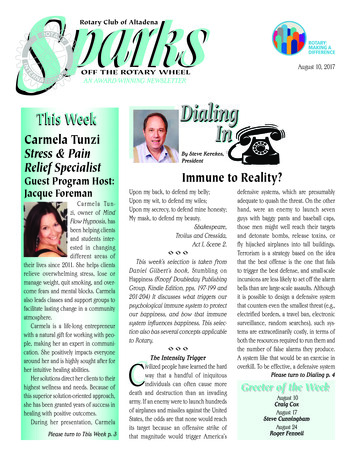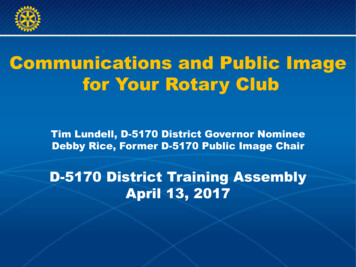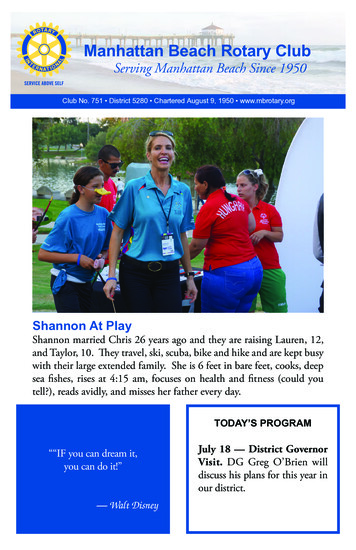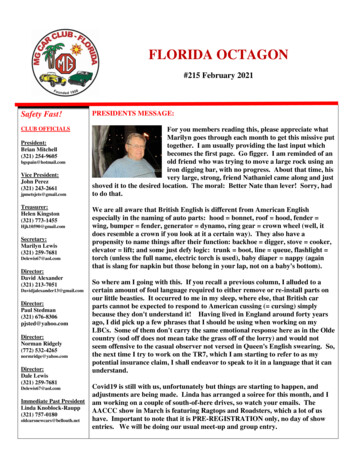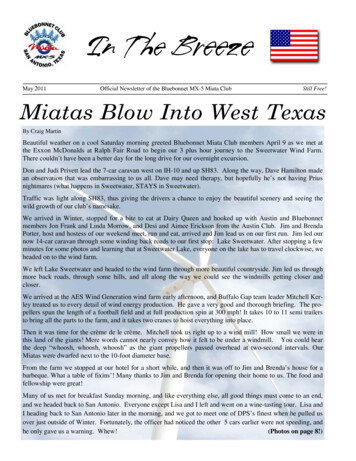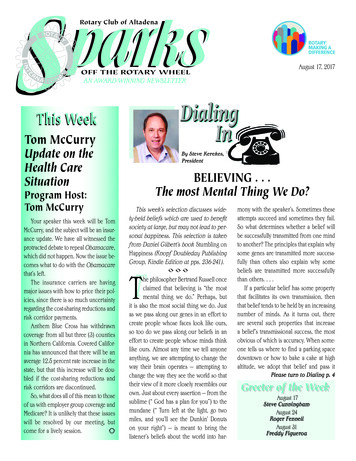
Transcription
Rotary Club of AltadenaAugust 17, 2017OFF THE ROTARY WHEELAN AWARD-WINNING NEWSLETTERDialingInThis WeekTom McCurryUpdate on theHealth CareSituationProgram Host:Tom McCurryYour speaker this week will be TomMcCurry, and the subject will be an insurance update. We have all witnessed theprotracted debate to repeal Obamacare,which did not happen. Now the issue becomes what to do with the Obamacarethat’s left.The insurance carriers are havingmajor issues with how to price their policies, since there is so much uncertaintyregarding the cost-sharing reductions andrisk corridor payments.Anthem Blue Cross has withdrawncoverage from all but three (3) countiesin Northern California. Covered California has announced that there will be anaverage 12.5 percent rate increase in thestate, but that this increase will be doubled if the cost-sharing reductions andrisk corridors are discontinued.So, what does all of this mean to thoseof us with employer group coverage andMedicare? It is unlikely that these issueswill be resolved by our meeting, butcome for a lively session.By Steve Kerekes,PresidentBELIEVING . . .The most Mental Thing We Do?This week’s selection discusses widely-held beliefs which are used to benefitsociety at large, but may not lead to personal happiness. This selection is takenfrom Daniel Gilbert’s book Stumbling onHappiness (Knopf Doubleday PublishingGroup. Kindle Edition at pps. 236-241). he philosopher Bertrand Russell onceclaimed that believing is “the mostmental thing we do.” Perhaps, butit is also the most social thing we do. Justas we pass along our genes in an effort tocreate people whose faces look like ours,so too do we pass along our beliefs in aneffort to create people whose minds thinklike ours. Almost any time we tell anyoneanything, we are attempting to change theway their brain operates — attempting tochange the way they see the world so thattheir view of it more closely resembles ourown. Just about every assertion — from thesublime (“ God has a plan for you”) to themundane (“ Turn left at the light, go twomiles, and you’ll see the Dunkin’ Donutson your right”) — is meant to bring thelistener’s beliefs about the world into har-Tmony with the speaker’s. Sometimes theseattempts succeed and sometimes they fail.So what determines whether a belief willbe successfully transmitted from one mindto another? The principles that explain whysome genes are transmitted more successfully than others also explain why somebeliefs are transmitted more successfullythan others. . . .If a particular belief has some propertythat facilitates its own transmission, thenthat belief tends to be held by an increasingnumber of minds. As it turns out, thereare several such properties that increasea belief’s transmissional success, the mostobvious of which is accuracy. When someone tells us where to find a parking spacedowntown or how to bake a cake at highaltitude, we adopt that belief and pass itPlease turn to Dialing p. 4Greeter of the WeekAugust 17Steve CunninghamAugust 24Roger FennellAugust 31Freddy Figueroa
Program ReviewYou are getting Sleepy . . .“Y“You aregettingsleepy very, very sleepy.”Our speaker this pastweek did not actuallysay these words, but this may have beenclose to what we all expected a clinicalhypnotherapist to say. Our speaker, CarmelaSparks is published 48 weeks a year and is theofficial publication of the Rotary Club of Altadena.The deadline for submission of articles is Friday at6p to current editor email, fax, or delivery.Rotary Club of Altadena - #7183Chartered: February 14, 1949P.O. Box 414, Altadena, CA 91003www.altadenarotary.comMeets: Thursday, 12:10pAltadena Town & Country Club2290 Country Club Drive Altadena, CA626-794-7163Rotary Int. Pres. Ian H.S. RiseleyDist 5300 Gov. . Raghada KhouryOfficersSteve Kerekes, Pres. .Bus. 626-796-5000Sarah O’Brien, Pres. Elec. .Bus. 310-902-6547Charlie Wilson, V. Pres. .Bus. 626-351-8815Mark Mariscal, Sec. . Bus. 323-816-6713Mike Noll, Trea. .Bus. 626-683-0515DirectorsMindy Kittay Anthony HillCharlie Wilson Dennis MehringerJames Gorton Sarah O’Brien Marc MariscalChairmenSarah O’Brien . AdministrationDavid Smith . FoundationSteve Cunningham .Asst. FoundationCraig Cox.MembershipJacque Foreman . Public AwarenessJacque Foreman .Acting PublicityJacque Foreman .Sparks/WebsiteMike Zoeller .Club ProjectsCraig Cox .CommunityDoug Colliflower .Asst. CommunityJohn Frykenberg .InternationalTony Hill . Youth Contests/AwardsMike Zoeller .Youth ProjectsRay Carlson .VocationalEditor, Design & Typesetting . Foreman GraphicsPhotography.Jacque Foreman2Tunzi, actually did her best to correct ourpreconceived notions as to what a hyponotherapist such as herself actually does.Carmela is a member of the NationalGuild of Hupnotists (NGH). She is certifiedas a Master Hypnotist. She teaches self-hypnosis at Glendale College. She helps clientsovercome stress, stop smoking, overcomedisabling fears and mental blocks, and sheguarantees her work. As an example, Carmela told us that she had developed a fearof driving on highways — a serious problemfor one who lives in the greater Los Angelesregion. When she would enter a highwayshe would get a panic attack and be unableto proceed. She attended the program of awell known hypnotherapist while in Hawaiiwho helped her overcome this problem. Itwas then that Carmela realized that this wasthe profession for her.She told us that mind and body need towork together. To help us understand thisconcept she had us stand, look upward andraise our arms and hands upward, smile andvisualize a happy thought and then frownand visualize a sad thought. Then she hadus sit down and look down and repeat thesame visualizations. She also gave us thea real life example of the intense look onAugustMembership - New Club DevelopmentProgram Chair, Tom McCurryAugust 24 - To be AnnouncedAugust 31 - To be AnnouncedSeptemberEducation & LiteracyProgram Chair, Mark MariscalMichael Phelps’ face at the Olympics justbefore he dove into the water. She said hewas visualizing the whole race and his performance, and this helped him to competeat his optimal peak.Carmela told us there are only 3 types ofpersons that cannot be helped by hypnosis: Those with an IQ below 70, Those who are convinced that hypnosisis a scam and refuse to participate, andPlease turn to Program, p. 3CongratulationsBirthdaysBirthdays08/08 - Joseph McMullin08/10 - Don Applegate08/30 - Paula Mariscal08/31 - Bruce Conroy (Jacque Foreman)Anniversaries08/23 - Dotty & Gary ClarkSparks - Altadena Rotary Club Newsletter
Chairmen’sornerby Jacque Foreman, Public Awareness ChairComing in SeptemberAnother Opportunity to doIndividual Community ServiceOK, I knowyour smirking. You already know what I’m talking about — at leastthose who are the longer-time members.And you are absolutely correct! I’m talkingabout the opportunity to help ChristmasTree Lane put up the lights.September isn’t very far off, and we’ll bestarting on our labor-intensive effort mostlikely on the first or second weekend inSeptember.You don’t have to climb ladders, though,if you are willing, that would be great. Mostof the hands will be tightening the socketson the lines and screwing in light bulbs.This year should be our first year with100 percent LED bulbs. But that brings itsown piece of intensive labor. Each bulbcomes in an individual box. The box mustbe opened, the bulb taken out and a gasketput on each bulb to help keep rain and othermoisture from getting into the socket andshorting out the bulb.And, there’s a specific order to the bulbs:that’s two colors and a clear (white in LEDbulbs.) So you will want to do somethinglike: red then green then clear and then blue then yellow then clearand continue that for the length of the lineon which you are working.If you can screw in a light bulb and knowyour colors, we can use your help. The workisn’t hard; it goes from 8 or 9am until noon,and then we feed you lunch.the drawn-out red pain as a slowly spinningball. Then she had him visualize the redball spinning in the opposite direction andfinally visualize sending it away.She then asked him to assign a colorto how the pain in his knees now felt, andKimmet said “blue.” Carmela had him visualize putting the blue from a blue coloredball back into his knees. Once he indicatedhe had finished replacing the red color withthe blue color, she announced he was done.When asked, Kimmet said he would nowdescribe the pain level he was experiencingas a 2.5, and clearly looked to be in less painas he returned to his seat.This was a very impressive demonstration. Carmela however cautioned us thathypnosis is about repetition and that thiswould need to be repeated several timesover the course of several weeks or months.She said it was not meant to diminish theimportance of pain in letting us know thereis a problem going on with our bodies.Rather it is to show the interactivity of mindand body and to help those who sometimesare feeling a greater level of pain than theyTony Hillneed to be experiencing.ProgramContinued from p.2 Those with severe mental disorders.To illustrate this she asked if there wasanyone at the meeting who was currentlyexperiencing pain. Kimmet Haggins put uphis hand. As a close to her presentation,she had him come up and sit in a chairfacing the group. In response to questionshe told her that, for the past 70 or so days,he has been experiencing pain in both ofhis knees, which on a scale of 1 to 10, tenbeing highest pain level, he described hispain level as a 6.Carmela had Kimmet take a deep breathand let it our slowly. She asked him to assigna color to his pain — he said “red.” She askedhim to close his eyes and visualize the painin his knees in red, then visualize slowlydrawing the pain out of his knees. When hefelt the pain was out. she had him visualizeSparks - Altadena Rotary Club Newsletter3
DialingContinued from p. 1along because it helps us and our friends dothe things we want to do, such as parkingand baking. As one philosopher noted, “Thefaculty of communication would not gainground in evolution unless it was by andlarge the faculty of transmitting true beliefs.”Accurate beliefs give us power, which makesit easy to understand why they are so readilytransmitted from one mind to another.It is a bit more difficult to understandwhy inaccurate beliefs are so readily transmitted from one mind to another — but theyare. False beliefs, like bad genes, can anddo become super-replicators, and a thoughtexperiment illustrates how this can happen.Imagine a game that is played by two teams,each of which has a thousand players,each of whom is linked to teammates by atelephone. The object of the game is to getone’s team to share as many accurate beliefsas possible. When players receive a messagethat they believe to be accurate, they calla teammate and pass it along. When theyreceive a message that they believe to be inaccurate, they don’t. At the end of the game,the referee blows a whistle and awards eachteam a point for every accurate belief thatthe entire team shares and subtracts onepoint for every inaccurate belief the entireteam shares. Now, consider a contest playedone sunny day between a team called thePerfects (whose members always transmitaccurate beliefs) and a team called theImperfects (whose members occasionallytransmit an inaccurate belief). We shouldexpect the Perfects to win, right?Not necessarily. In fact, there are somespecial circumstances under which the Imperfects will beat their pants off. For example, imagine what would happen if one ofthe Imperfect players sent the false message“Talking on the phone all day and nightwill ultimately make you very happy,” andimagine that other Imperfect players weregullible enough to believe it and pass it on.4This message is inaccurate and thus will costthe Imperfects a point in the end. But it mayhave the compensatory effect of keepingmore of the Imperfects on the telephone formore of the time, thus increasing the totalnumber of accurate messages they transmit.Under the right circumstances, the costs ofthis inaccurate belief would be outweighedby its benefits, namely, that it led players tobehave in ways that increased the odds thatthey would share other accurate beliefs.The lesson to be learned from this gameis that inaccurate beliefs can prevail in thebelief-transmission game if they somehowfacilitate their own means of transmission. False beliefs that happen to promotestable societies tend to propagate becausepeople who hold these beliefs tend to livein stable societies, which provide the meansby which false beliefs propagate.Some of our cultural wisdom about happiness looks suspiciously like a super-replicating false belief. Consider money. If you’veever tried to sell anything, then you probablytried to sell it for as much as you possiblycould, and other people probably tried tobuy it for as little as they possibly could.All the parties involved in the transactionassumed that they would be better off ifthey ended up with more money rather thanless, and this assumption is the bedrock ofour economic behavior. Yet, it has far fewerscientific facts to substantiate it than youmight expect. Economists and psychologistshave spent decades studying the relation between wealth and happiness, and they havegenerally concluded that wealth increaseshuman happiness
Steve Cunningham August 24 Roger Fennell August 31 Freddy Figueroa BELIEVING . . . The most Mental Thing We Do? Please turn to Dialing p. 4 Tom McCurry Update on the Health Care Situation Program Host: Tom McCurry By Steve Kerekes, President Your speaker this week will be Tom McCurry, and the subject will be an insur-ance update. We have all witnessed the protracted debate to repeal
